A Preliminary Analysis of Anthropogenic and Natural Impacts on a Volcanic Lake Ecosystem in Southern Italy by UAV-Based Monitoring
Abstract
1. Introduction
2. Materials and Methods
2.1. Study Area
2.2. UAV Images Acquisition
3. Results
3.1. Natural Stressors
3.2. Anthropic Stressors
4. Discussion
5. Conclusions
- (1)
- The multi-temporal UAV data analysis revealed rapid changes in the lake-water level and made it possible to estimate the submerged and flooded shores. These areas, which reach sizes of up to about 90,000 m2 during winter, are one of the main causes of the fragmentation and degradation of habitats, as reported by different studies in the literature.
- (2)
- The UAV images showed the presence of hazardous algal blooms and cyanobacteria in autumn months due to the increase of temperatures, thus creating favourable conditions for phytoplankton development.
- (3)
- The orthophoto analysis made it possible to quantify the impact of structures and infrastructures on the environment surrounding the lake. In particular, the road around the lake is a major source of discontinuity in the landscape and the ecological network, preventing or partially limiting the connectivity of the natural ecosystem.
- (4)
- The proposed monitoring methodology would be useful for planning measures and interventions aimed at restoring the native riparian and aquatic environments, as well as regulating or prohibiting activities with a high negative impact on the flora and fauna species.
Author Contributions
Funding
Institutional Review Board Statement
Informed Consent Statement
Data Availability Statement
Conflicts of Interest
References
- Varotsos, C.A.; Krapivin, V.F.; Mkrtchyan, F.A.; Gevorkyan, S.A.; Cui, T. A Novel Approach to Monitoring the Quality of Lakes Water by Optical and Modeling Tools: Lake Sevan as a Case Study. Water Air Soil Pollut. 2020, 231, 435. [Google Scholar] [CrossRef]
- Moss, B. Cogs in the endless machine: Lakes, climate change and nutrientcycles: A review. Sci. Total Environ. 2012, 434, 130–142. [Google Scholar] [CrossRef] [PubMed]
- Dörnhöfer, K.; Oppelt, N. Remote sensing for lake research and monitoring—Recent advances. Ecol. Indic. 2016, 64, 105–122. [Google Scholar] [CrossRef]
- Aoki, I. Lake Ecosystems. In Entropy Principle for the Development of Complex Biotic Systems, 1st ed.; Elsevier: Amsterdam, Netherlands, 2012; pp. 73–86. [Google Scholar]
- Adrian, R.; O’Reilly, C.M.; Zagarese, H.; Baines, S.B.; Hessen, D.O.; Keller, W.; Living-stone, D.M.; Sommaruga, R.; Straile, D.; van Donk, E.; et al. Lakes as sentinels of climate change. Limnol. Oceanogr. 2009, 54, 2283–2297. [Google Scholar] [CrossRef] [PubMed]
- Brönmark, C.; Hansson, L.A. Environmental issues in lakes and ponds: Current state and perspectives. Environ. Conserv. 2002, 29, 290–307. [Google Scholar] [CrossRef]
- Dudgeon, D.; Arthington, A.H.; Gessner, M.O.; Kawabata, Z.I.; Knowler, D.J.; Lévêque, C.; Naiman, R.J.; Prieur-Richard, A.H.; Soto, D.; Stiassny, M.L.J.; et al. Freshwater biodiversity: Importance, threats, status and conservation challenges. Biol. Rev. Camb. Philos. Soc. 2006, 81, 163–182. [Google Scholar] [CrossRef]
- Jones, B.A.; Fleck, J. Shrinking lakes, air pollution, and human health: Evidence from California’s Salton Sea. Sci. Total Environ. 2020, 712, 136490. [Google Scholar] [CrossRef]
- Gray, W.B.; Shimshack, J.P. The effectiveness of environmental monitoring and enforcement: A review of the empirical evidence. Rev. Environ. Econ. Policy 2011, 5, 3–24. [Google Scholar] [CrossRef]
- Birk, S.; Bonne, W.; Borja, A.; Brucet, S.; Courrat, A.; Poikane, S.; Solimini, A.; vande Bund, W.; Zampoukas, N.; Hering, D. Three hundred ways to assess Europe’s surface waters: An almost complete overview of biological methods to implement the Water Framework Directive. Ecol. Indic. 2012, 18, 31–41. [Google Scholar] [CrossRef]
- Warne, M.S.J.; Batley, M.J.; Braga, G.E.; Chapman, O.; Fox, J.C.; Hickey, D.R.; Stauber, C.W.; van Dam, J.L.R. Revisions to the derivation of the Australian and New Zealand guidelines for toxicants in fresh and marine waters. Environ. Sci. Pollut. Res. 2014, 21, 51–60. [Google Scholar] [CrossRef]
- Schaeffer, B.A.; Schaeffer, K.G.; Keith, D.J.; Lunetta, R.S.; Conmy, R.; Gould, R.W. Barriers to adopting satellite remote sensing for water quality management. Int. J. Remote Sens. 2013, 34, 7534–7544. [Google Scholar] [CrossRef]
- Reyjol, Y.; Argillier, C.; Bonne, W.; Borja, A.; Buijse, A.D.; Cardoso, A.C.; Daufresne, M.; Kernan, M.; Ferreira, M.T.; Poikane, S.; et al. Assessing the eco-logical status in the context of the European Water Framework Directive: Where do we go now? Sci. Total Environ. 2014, 497–498, 332–344. [Google Scholar] [CrossRef] [PubMed]
- Williamson, C.E.; Saros, J.E.; Vincent, W.F.; Smol, J.P. Lakes and reservoirs as sentinels, integrators, and regulators of climate change. Limnol. Oceanogr. 2009, 54, 2273–2282. [Google Scholar] [CrossRef]
- Hestir, E.L.; Brando, V.E.; Bresciani, M.; Giardino, C.; Matta, E.; Villa, P.; Dekker, A.G. Measuring freshwater aquatic ecosystems: The need for a hyperspectral global mapping satellite mission. Remote Sens. Environ. 2015, 167, 181–195. [Google Scholar] [CrossRef]
- van Puijenbroek, P.; Evers, C.; van Gaalen, F.W. Evaluation of Water Framework Directive metrics to analyse trends in water quality in the Netherlands. Sustain. Water Qual. Ecol. 2015, 6, 40–47. [Google Scholar] [CrossRef]
- Fabbri, S.; Grottoli, E.; Armaroli, C.; Ciavola, P. Using high-spatial resolution UAV-derived data to evaluate vegetation and geomorphological changes on a dune field involved in a restoration endeavour. Remote Sens. 2021, 13, 1987. [Google Scholar] [CrossRef]
- Medvedev, A.; Telnova, N.; Alekseenko, N.; Koshkarev, A.; Kuznetchenko, P.; Asmaryan, S.; Narykov, A. UAV-derived data application for environmental monitoring of the coastal area of Lake Sevan, Armenia with a changing water level. Remote Sens. 2020, 12, 3821. [Google Scholar] [CrossRef]
- Allen, J.R.M.; Huntley, B. Last Interglacial palaeovegetation, palaeoenvironments and chronology: A new record from Lago Grande di Monticchio, southern Italy. Quat. Sci. Rev. 2009, 28, 1521–1538. [Google Scholar] [CrossRef]
- Spicciarelli, R.; Mirauda, D.; Mancino, G. Lago Grande in Monticchio Area (Southern Italy): Integrating Multitemporal Airborne Images, Satellite Images (Sentinel-2) and Historical Data to Assess the Extent of Nymphaea alba L. and Taxodium distichum (L.) Rich in Natural Habitats of Directive 92/43/EEC. Int. J. Agric. Sustain. Dev. 2020, 2, 1–23. [Google Scholar]
- Spicciarelli, R. New bioethological observations on Brahmaea (Acanthobrahmaea) europaea and its host plants in Special Area of Conservation “Grotticelle di Monticchio” (Basilicata, Southern Italy) (Lepidoptera: Brahmaeidae). Fragm. Entomol. 2018, 50, 43–52. [Google Scholar] [CrossRef]
- Rosen, M.A.; Bulucea, C.A.; Mastorakis, N.E.; Bulucea, C.A.; Jeles, A.C.; Brindusa, C.C. Evaluating the thermal pollution caused by wastewaters discharged from a chain of coal-fired power plants along a river. Sustainability 2015, 7, 5920–5943. [Google Scholar] [CrossRef]
- AgiSoft PhotoScan Pro. Image quality. In Agisoft Metashape User Manual: Professional Edition, Version 1.5; Agisoft LLC: St. Petersburg, Russia, 2019. [Google Scholar]
- Mancini, F.; Dubbini, M.; Gattelli, M.; Stecchi, F.; Fabbri, S.; Gabbianelli, G. Using Unmanned Aerial Vehicles (UAV) for High- Resolution Reconstruction of Topography: The Structure from Motion Approach on Coastal Environments. Remote Sens. 2013, 5, 6880–6898. [Google Scholar] [CrossRef]
- Sakharova, E.G.; Krylov, A.V.; Sabitova, R.Z.; Tsvetkov, A.I.; Gambaryan, L.R.; Mamyan, A.S.; Gabrielyan, B.K.; Hayrapetyan, A.H.; Khachikyan, T.G. Horizontal and Vertical Distribution of Phytoplankton in the Alpine Lake Sevan (Armenia) during the Summer Cyanoprokaryota bloom. Contemp. Probl. Ecol. 2020, 13, 60–70. [Google Scholar] [CrossRef]
- Ortega-Terol, D.; Hernandez-Lopez, D.; Ballesteros, R.; Gonzalez-Aguilera, D. Automatic hotspot and sun glint detection in UAV multispectral images. Sensors 2017, 17, 2352. [Google Scholar] [CrossRef] [PubMed]
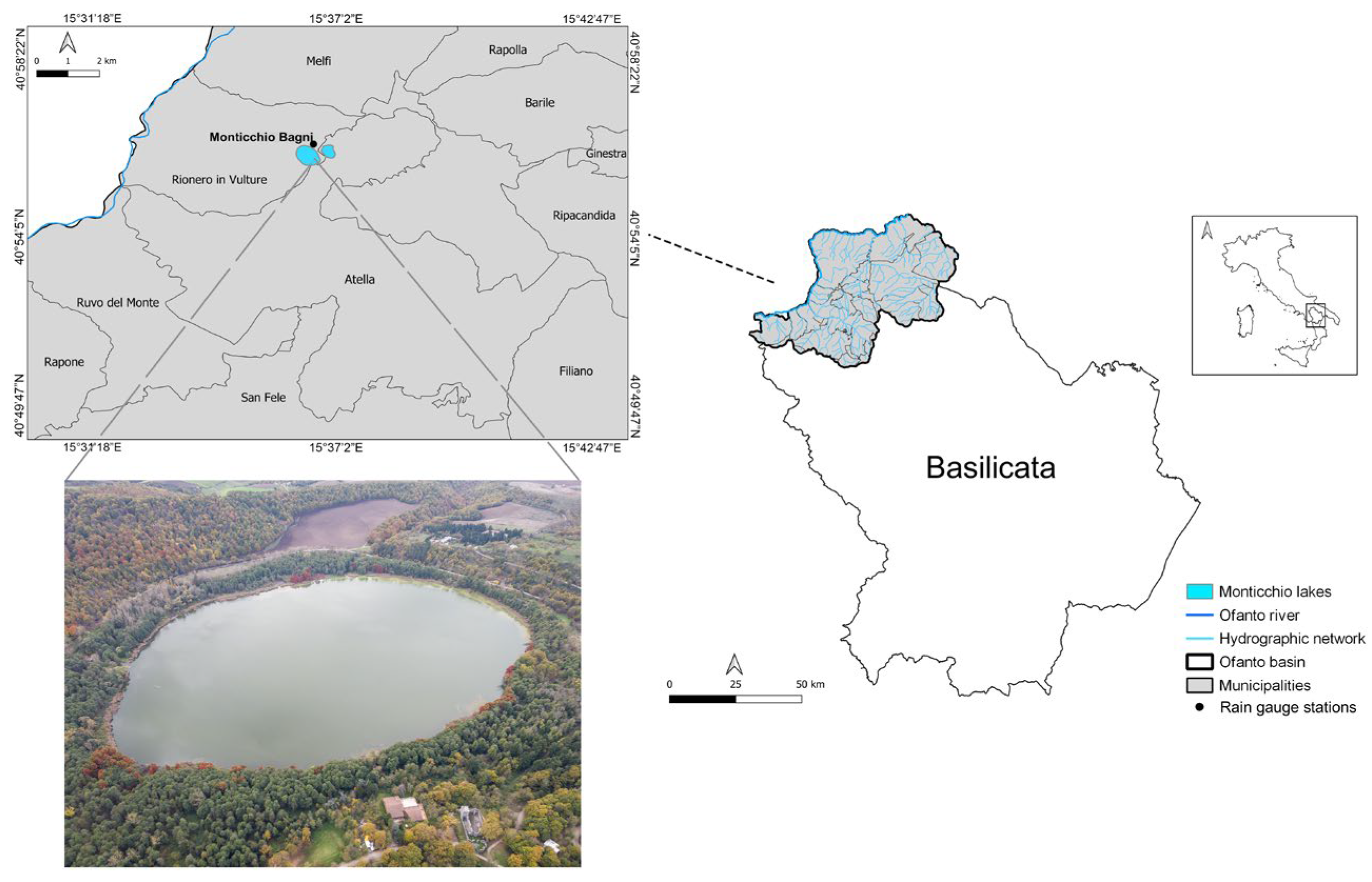
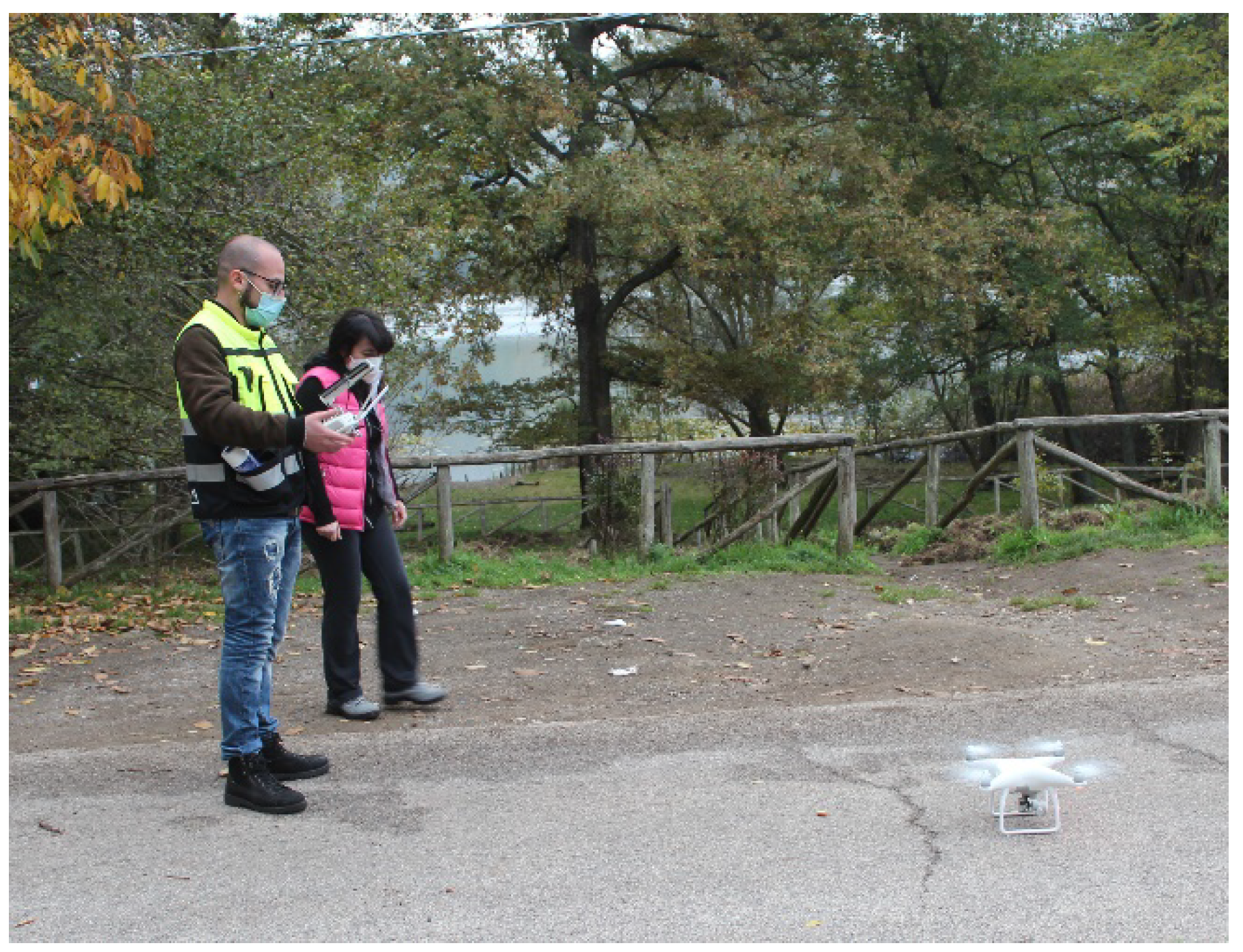

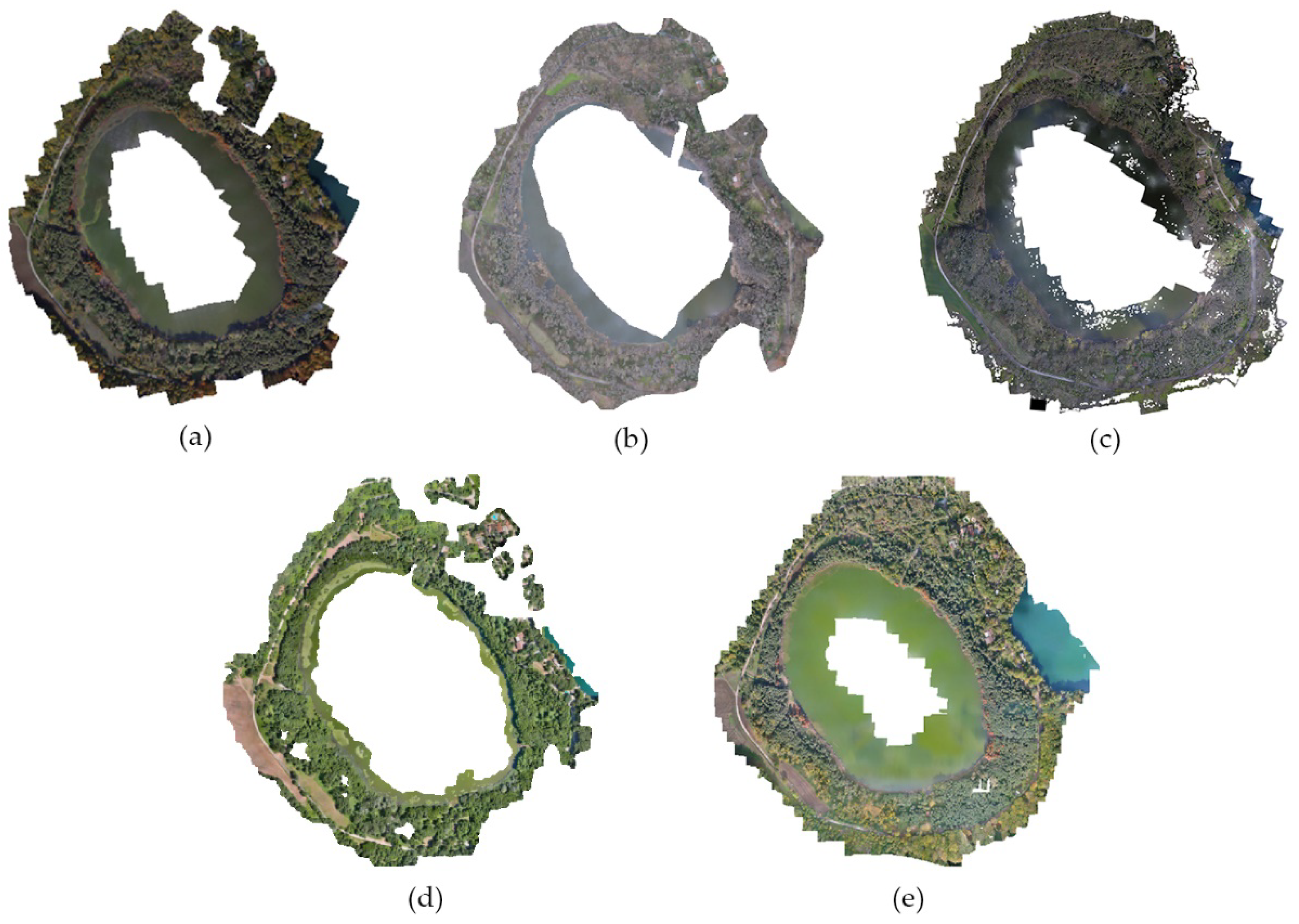
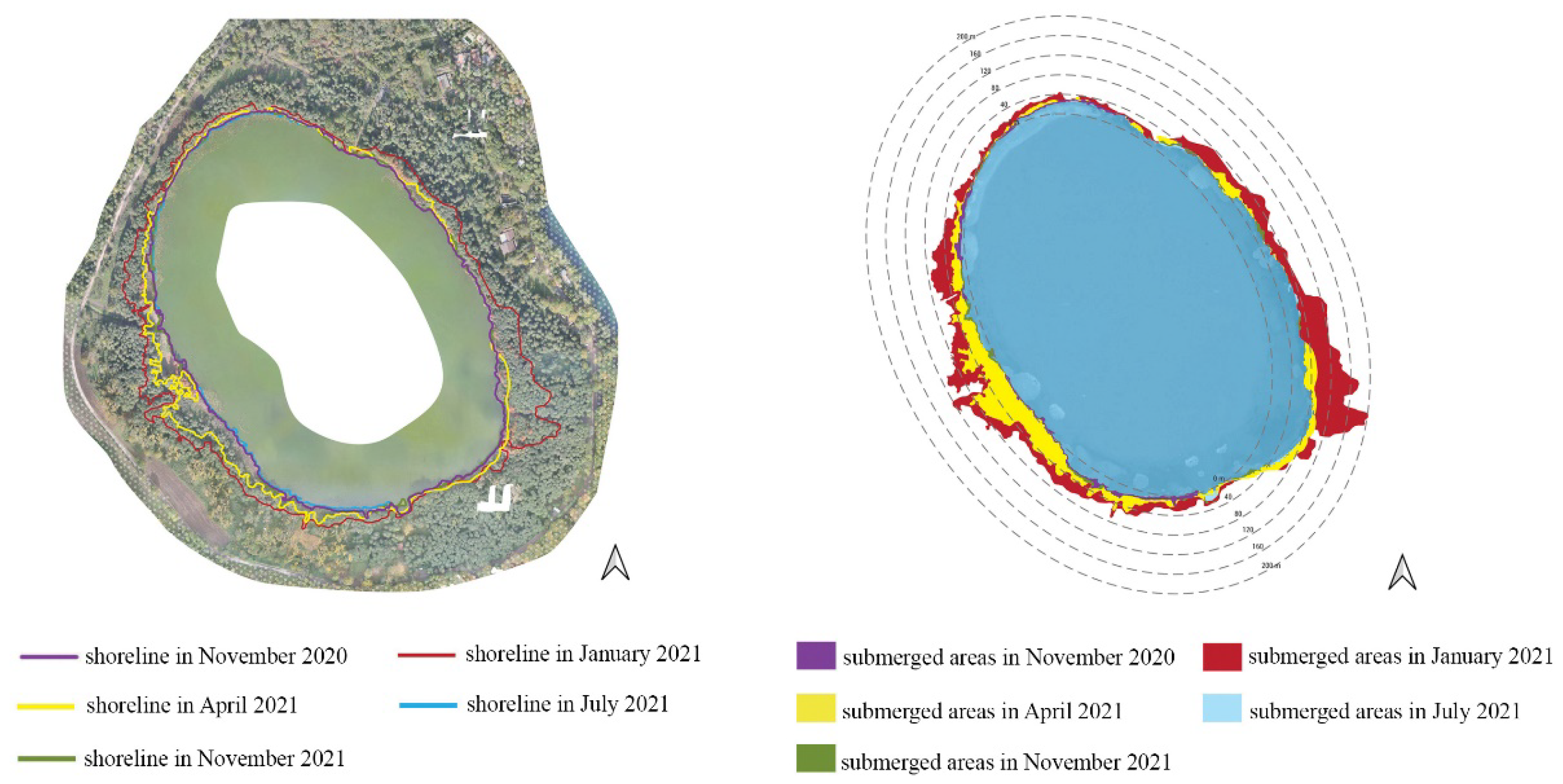



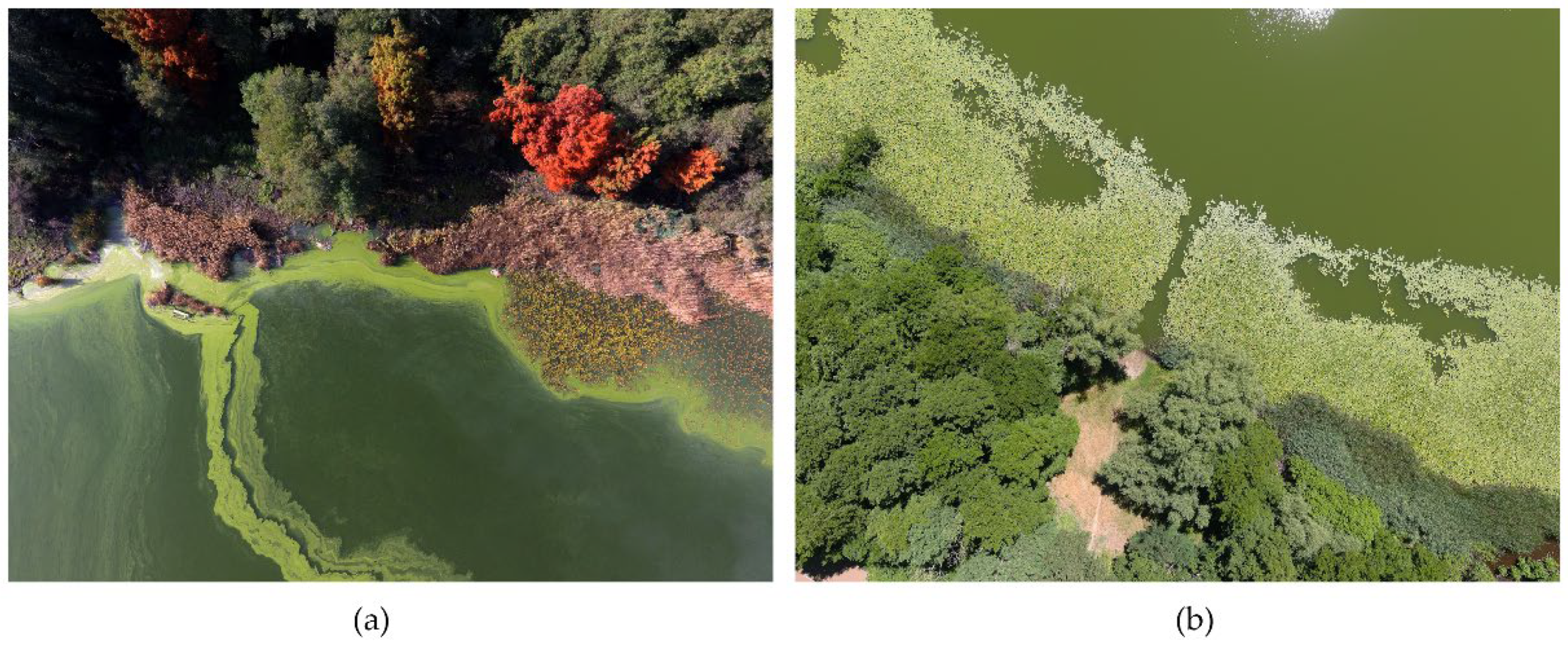
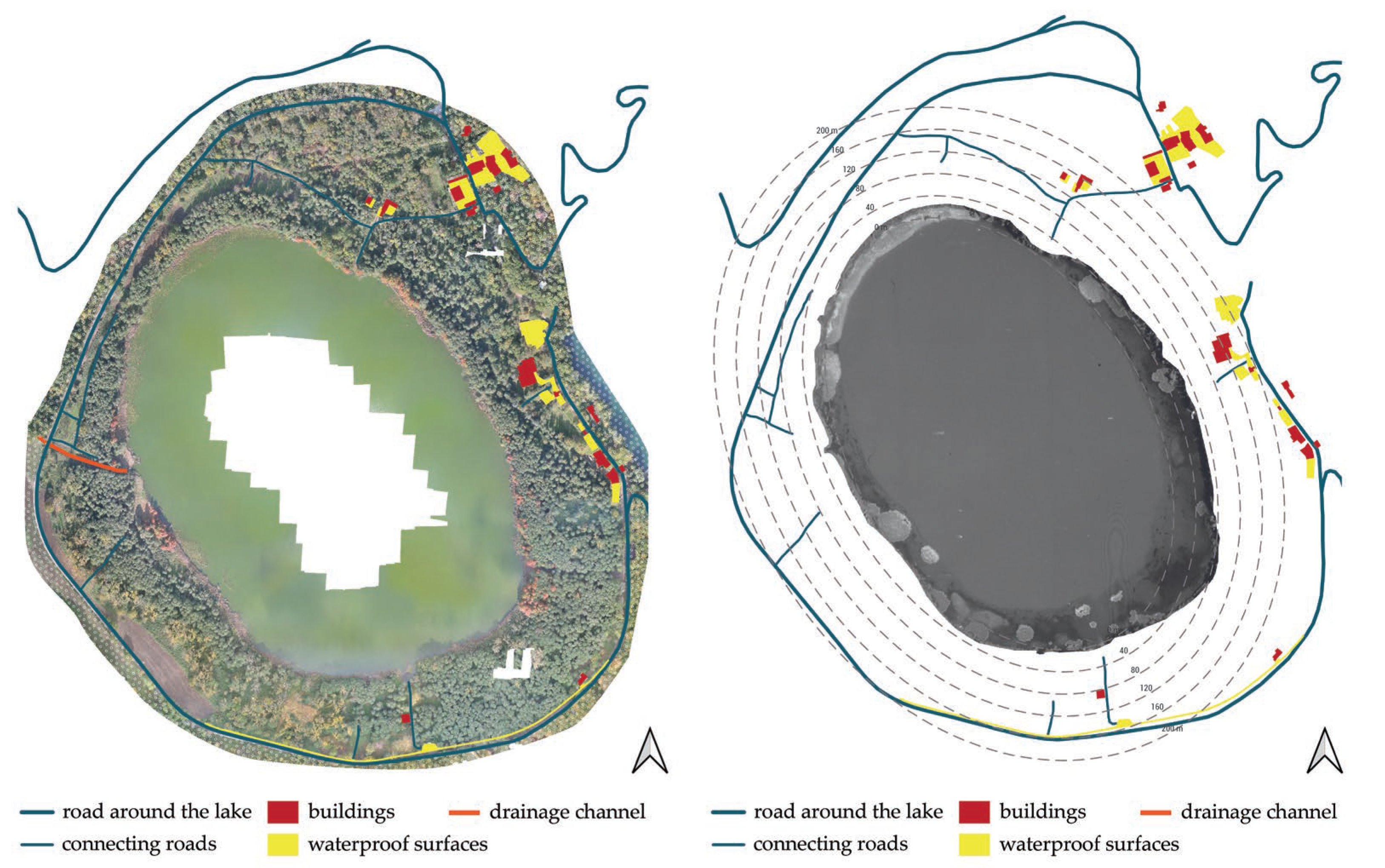
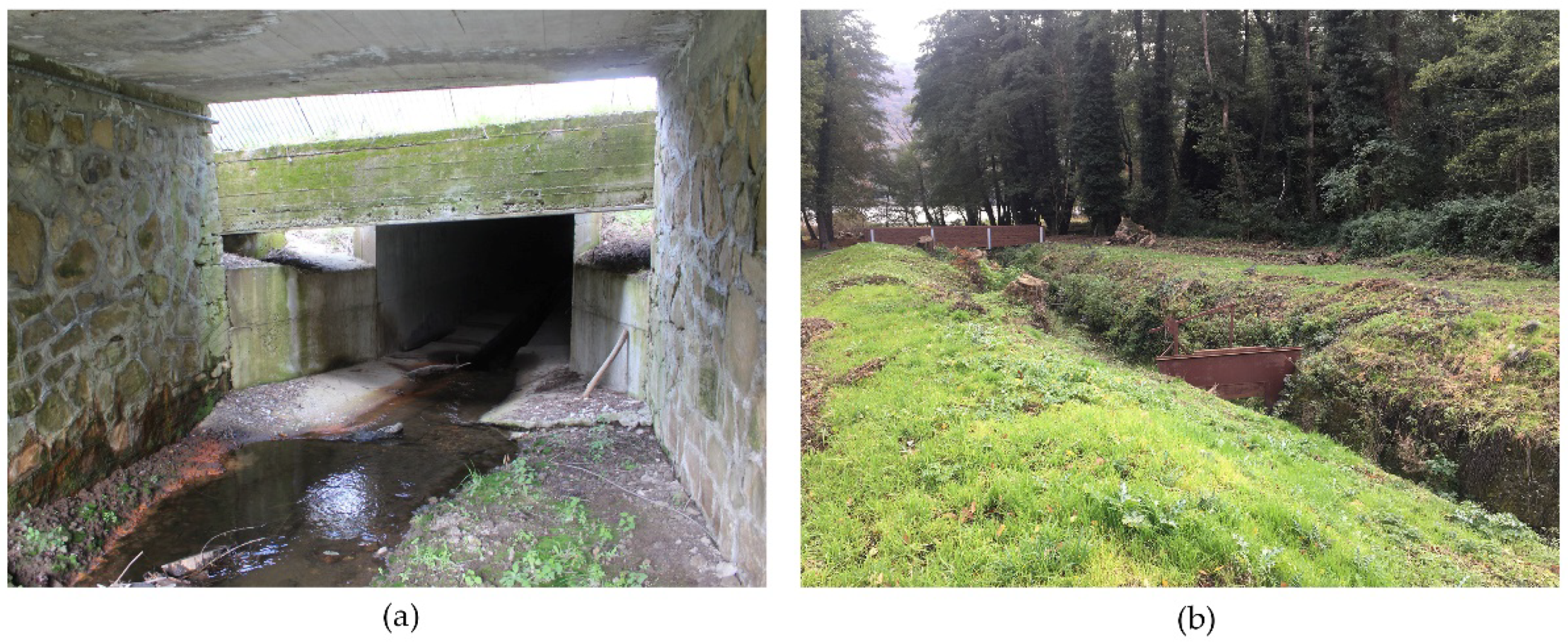
| Typologies | 1990 | 2018 | 2018–1990 |
|---|---|---|---|
| Continuous urban fabric | 0.26% | 0.73% | 0.47% |
| Discontinuous urban fabric | 1.07% | 2.14% | 1.07% |
| Industrial or commercial units | 0.92% | 2.10% | 1.18% |
| Mineral extraction sites | 0.04% | 0.21% | 0.17% |
| Non-irrigated arable land | 19.37% | 16.54% | −2.83% |
| Vineyards | 2.99% | 6.21% | 3.22% |
| Fruit trees and berry plantations | 0.16% | 0.70% | 0.54% |
| Olive groves | 9.90% | 11.93% | 2.03% |
| Pastures | 1.11% | 1.91% | 0.80% |
| Annual crops associated with permanent crops | 10.23% | 0.13% | −10.10% |
| Complex cultivation patterns | 5.00% | 11.10% | 6.10% |
| Land principally occupied by agriculture with significant areas of natural vegetation | 4.33% | 16.14% | 11.81% |
| Broad-leaved forest | 36.49% | 12.15% | −24.34% |
| Coniferous forest | 0.04% | 0.60% | 0.56% |
| Mixed forest | 0.80% | 1.32% | 0.52% |
| Natural grasslands | 3.19% | 4.95% | 1.76% |
| Sclerophyllous vegetation | 0.70% | 0.12% | −0.58% |
| Transitional woodland-shrub | 2.62% | 9.60% | 6.98% |
| Beaches—dunes—sands | 0.04% | 0.20% | 0.16% |
| Inlands marshes | 0.24% | 0.40% | 0.16% |
| Water bodies | 0.50% | 0.80% | 0.30% |
| Typologies | 2013 |
|---|---|
| Fresh waters | 0.15% |
| Eastern sub-Mediterranean white oak woods | 1.47% |
| Southern Italian quercus frainetto woods | 5.06% |
| Chestnut woods | 1.15% |
| Quarries | 0.17% |
| Southern Italian quercus cerris woods | 7.10% |
| Middle-European rich-soil thickets | 1.21% |
| Towns | 1.11% |
| Extensive cultivation | 12.28% |
| Southern Italian beech forests | 0.72% |
| Mediterranean riparian poplar forests | 1.37% |
| Fruit orchards | 0.34% |
| Mediterranean gravel beds | 0.19% |
| Italian supra-Mediterranean holm-oak forests | 0.07% |
| Oleo-Ientisc brush | 0.05% |
| Olive groves | 4.63% |
| Conifer plantations | 0.55% |
| Eucalyptus plantations | 0.05% |
| Sub-Mediterranean Mesobromion | 1.98% |
| Central and southern Apennine dry grasslands | 2.11% |
| Middle-European Brachypodium-dominated semi dry grasslands | 0.15% |
| Mesophile pastures | 0.80% |
| Medlterranean subnitrophilous grass communities | 4.01% |
| Southern Italian and Sicilian quercus pubescens woods | 0.31% |
| Unbroken intensive cropland | 49.31% |
| Active industrial sites | 0.56% |
| Reed beds | 0.10% |
| Tyrrhenian sub-Mediterranean deciduous thickets | 1.39% |
| Vineyards | 0.89% |
| Survey | RMSE (m) |
|---|---|
| 16 November 2020 | 0.001 |
| 29 January 2021 | 0.025 |
| 15 April 2021 | 0.007 |
| 27 July 2021 | 0.048 |
| 10 November 2021 | 0.023 |
Disclaimer/Publisher’s Note: The statements, opinions and data contained in all publications are solely those of the individual author(s) and contributor(s) and not of MDPI and/or the editor(s). MDPI and/or the editor(s) disclaim responsibility for any injury to people or property resulting from any ideas, methods, instructions or products referred to in the content. |
© 2022 by the authors. Licensee MDPI, Basel, Switzerland. This article is an open access article distributed under the terms and conditions of the Creative Commons Attribution (CC BY) license (https://creativecommons.org/licenses/by/4.0/).
Share and Cite
Mirauda, D.; Padula, M.G.; Mirauda, E.; Paternò, C.; D’Onofrio, F.; Loguercio, D. A Preliminary Analysis of Anthropogenic and Natural Impacts on a Volcanic Lake Ecosystem in Southern Italy by UAV-Based Monitoring. Int. J. Environ. Res. Public Health 2023, 20, 5. https://doi.org/10.3390/ijerph20010005
Mirauda D, Padula MG, Mirauda E, Paternò C, D’Onofrio F, Loguercio D. A Preliminary Analysis of Anthropogenic and Natural Impacts on a Volcanic Lake Ecosystem in Southern Italy by UAV-Based Monitoring. International Journal of Environmental Research and Public Health. 2023; 20(1):5. https://doi.org/10.3390/ijerph20010005
Chicago/Turabian StyleMirauda, Domenica, Maria Giuseppina Padula, Enza Mirauda, Claudio Paternò, Fiorenzo D’Onofrio, and Domenico Loguercio. 2023. "A Preliminary Analysis of Anthropogenic and Natural Impacts on a Volcanic Lake Ecosystem in Southern Italy by UAV-Based Monitoring" International Journal of Environmental Research and Public Health 20, no. 1: 5. https://doi.org/10.3390/ijerph20010005
APA StyleMirauda, D., Padula, M. G., Mirauda, E., Paternò, C., D’Onofrio, F., & Loguercio, D. (2023). A Preliminary Analysis of Anthropogenic and Natural Impacts on a Volcanic Lake Ecosystem in Southern Italy by UAV-Based Monitoring. International Journal of Environmental Research and Public Health, 20(1), 5. https://doi.org/10.3390/ijerph20010005






